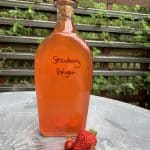Strawberry Vinegar
Making vinegar is an excellent zero waste way to use bruised strawberries and tops. Use this strawberry-sweet vinegar in dressings or as a shrub in summery cocktails or mocktails.
Ingredients
- 4 cups Strawberry scraps tops, hulls, bruised, but not moldy
- 1 quarts water
- ½ cup sugar
Instructions
- Add your scraps to a clean, wide-mouthed, non-metallic vessel, filling it 1/2 to 3/4 full.
- Make a sugar solution with a ratio of 1/2 cup of sugar to 1 quart water. Bring to a boil to dissolve the sugar. Let cool to at least room temperature.
- Pour the sugar solution over the scraps to completely cover them, but don't fill the jar, you'll need the room for solution displaced when you add weight to hold down the scraps.
- Make more solution with the 1/2 cup sugar to 1 quart water ratio if you need more to cover.
- Use a fermentation weight or make something to weigh down the scraps in the solution, such as a lidded jar full of water. Push down on the weight so that the scraps are fully submerged by the solution. Add more solution or water if you have space left in your jar. Pull out any scraps that float to the surface as they will mold, being exposed to air.
- Cover the top of the vessel with cheesecloth, coffee filter, or flour sack towel and use a rubberband to hold it in place.
- Put your jars in a dark, room temperature location, in something to catch any liquid that might overflow out during the fermentation process. Cover with a towel to keep out the light.
- Check your jars every couple of days, making sure scraps are staying under the solution. Pull out any moldy scraps on the surface and gently push on the weights to circulate the solution.
- Continue this for 3 weeks to let it ferment and then strain your mixture.
- Pour the solution into a clean, non-metallic jar. Add a vinegar mother from another batch of vinegar you've made or from a commercial vinegar with the mother in it. Put your covering back on top, secure with a rubberband, and return to the spot you were fermenting in. Stir every few days.
- It will take another few weeks for the mixture to turn into vinegar. Smell and taste the solution to determine when it’s the tartness you want and that no alcohol remains.
- Transfer to a smaller, narrow neck bottle and seal tightly to keep from oxidizing.
